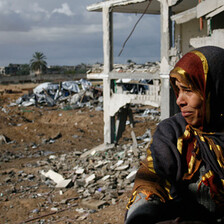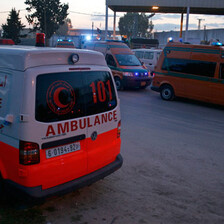Rafah, Gaza Strip 22 January 2009

A Palestinian wounded in Israel’s assault on Gaza is treated for burns at a hospital in Rafah, southern Gaza Strip, 12 January 2009. (Hatem Omar/MaanImages)
Workers have cleared most of the roads. Now, they are removing massive piles of wreckage and debris, much as people do following an earthquake.
“Yet, all the world helps after an earthquake,” said a doctor at al-Shifa Hospital in Gaza. “We feel very frustrated,” he continued. “The West, Europe and the US watched this killing go on for 22 days, as though they were watching a movie, watching the killing of women and children without doing anything to stop it. I was expecting to die at any moment. I held my babies and expected to die. There was no safe place in Gaza.”
He and his colleagues are visibly exhausted, following weeks of work in the intensive care and emergency room departments at a hospital that received many more patients than they could help. “Patients died on the floor of the operating room because we had only six operating rooms,” said Dr. Saeed Abuhassan, an intensive care unit doctor who grew up in Chicago. “And really we don’t know enough about the kinds of weapons that have been used against Gaza.”
In 15 years of practice, Dr. Abuhassan says he never saw burns like those he saw here. The burns, blackish in color, reached deep into the muscles and bones. Even after treatment began, the blackish color returned.
Two of the patients were sent to Egypt because they were in such critical condition. They died in Egypt. But when autopsies were done, reports showed that the cause of death was poisoning from elements of white phosphorous that had entered their systems, causing cardiac arrest.
In Gaza City, the burn unit’s harried director, a plastic surgeon and an expert in treating burns, told us that after encountering cases they’d never seen before, doctors at the center performed a biopsy on a patient they believed may have suffered chemical burns and sent the sample to a laboratory in Egypt. The results showed elements of white phosphorous in the tissue.
The doctor was interrupted by a phone call from a farmer who wanted to know whether it was safe to eat the oranges he was collecting from groves that had been uprooted and bombed during the Israeli invasion. The caller said the oranges had an offensive odor and that when the workers picked them up their hands became itchy.
Audrey Stewart, a human rights worker, had just spent the morning with Gaza farmers in Tufaa, a village near the border between Gaza and Israel. Israeli soldiers had first evacuated people, then dynamited the houses, then used bulldozers to clear the land, uprooting the orange tree groves. Many people, including children, were picking through the rubble, salvaging belongings and trying to collect oranges. At one point, people began shouting at Audrey, warning her that she was standing next to an unexploded rocket.
The doctor put his head in his hands, after listening to Audrey’s report. “I told them to wash everything very carefully. But these are new situations. Really, I don’t know how to respond,” he said.
Yet he spoke passionately about what he knew regarding families that had been burned or crushed to death when their homes were bombed. “Were their babies a danger to anyone?” he asked us.
“They are lying to us about democracy and Western values,” he continued, his voice shaking. “If we were sheep and goats, they would be more willing to help us.”
Dr. Saeed Abuhassan was bidding farewell to the doctors he’d worked with in Gaza. He was returning to his work in the United Arab Emirates. But before leaving, he paused to give us a word of advice. “You know, the most important thing you can tell people in your country is that American people paid for many of the weapons used to kill people in Gaza,” said Dr. Saeed Abuhassan. “And this, also, is why it’s worse than an earthquake.”
Kathy Kelly co-coordinates Voices for Creative Nonviolence and can be reached at kathy A T vcnv D O T org.
Related Links





